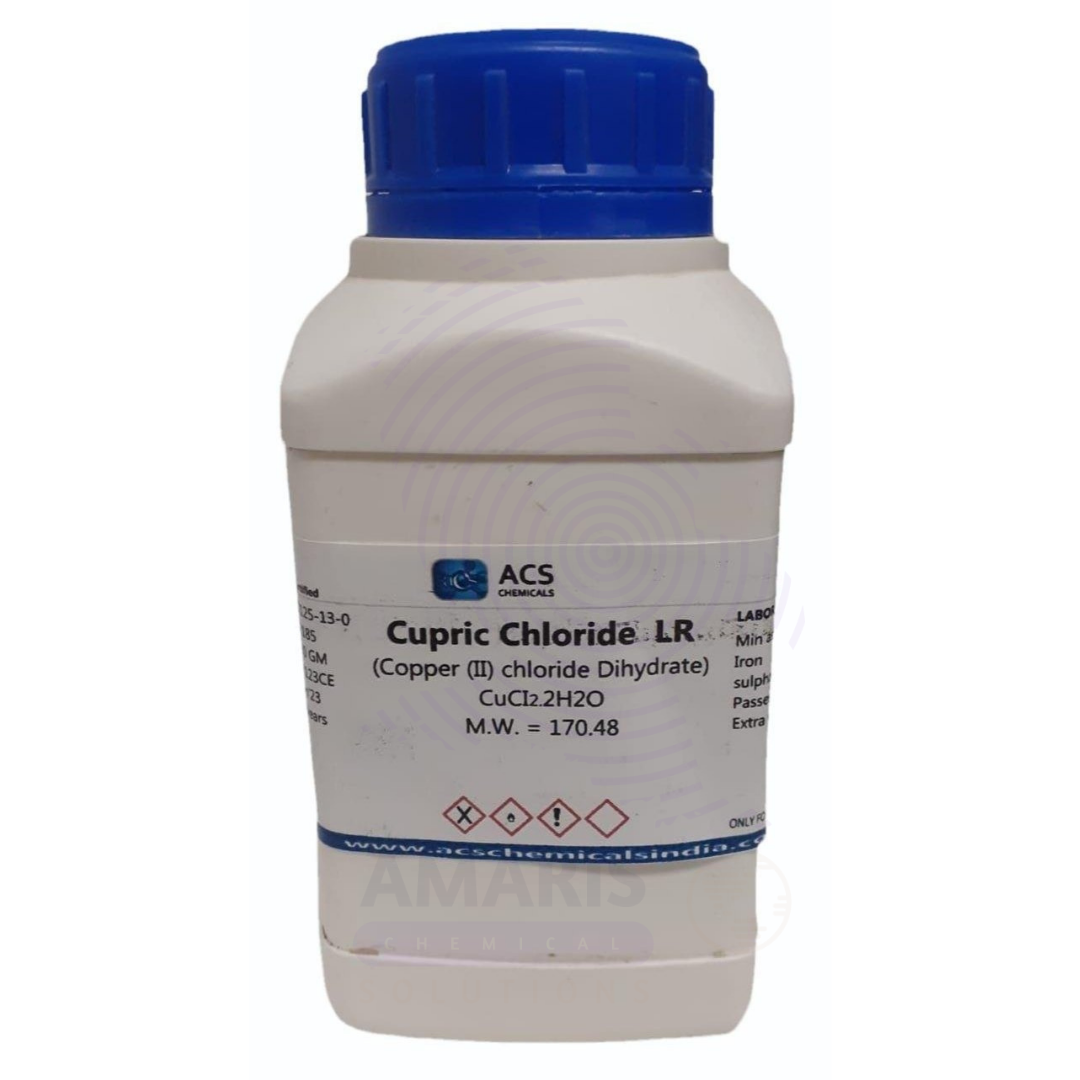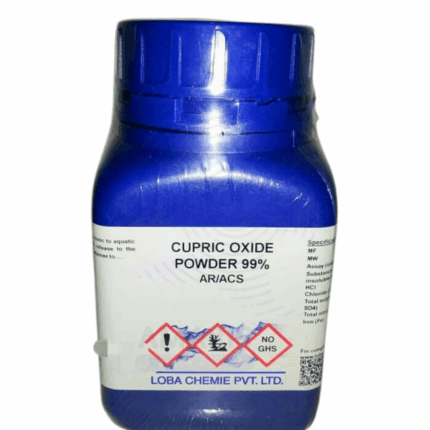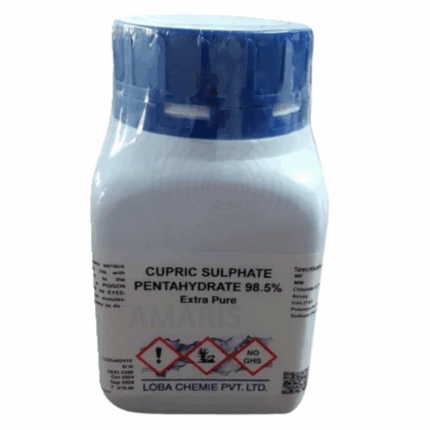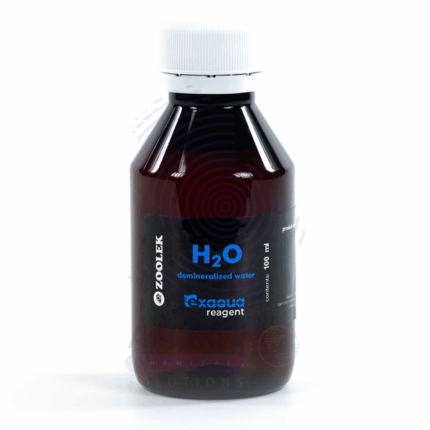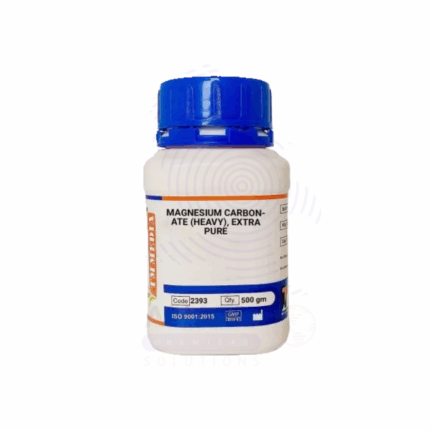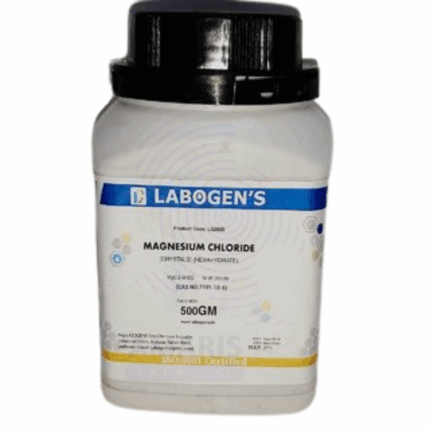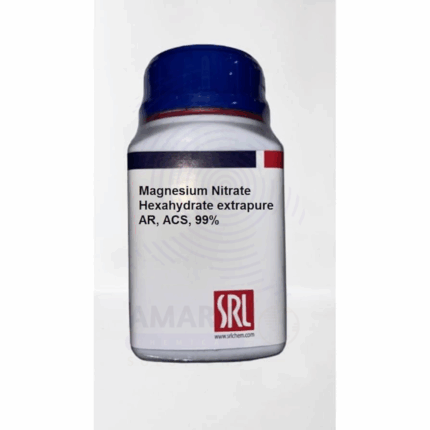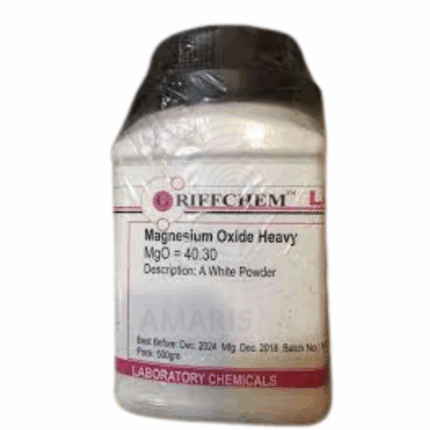Cupric Chloride Extra Pure
$ 19.00 Original price was: $ 19.00.$ 18.78Current price is: $ 18.78.
Cupric Chloride Extra Pure is a green to yellowish crystalline compound widely used in laboratories as a catalyst, reagent, and source of copper ions in various chemical reactions. It plays a key role in organic synthesis, photochemical processes, and analytical chemistry procedures, especially for detecting reducing agents and halide ions. Its high solubility in water and alcohol allows for versatile application across wet-lab experiments. The extra pure grade ensures excellent reliability and minimal impurities, making it ideal for precision work in research and education. Store in a cool, dry place, protected from moisture and light to preserve its reactivity.
Cupric Chloride Extra Pure
Primary Uses
- Inorganic Synthesis
- Acts as a starting material for various copper-based compounds and complexes.
- Frequently used in coordination chemistry experiments involving ligands like ammonia, EDTA, or chloride ions.
- Catalysis in Organic Reactions
- Functions as a Lewis acid catalyst in chlorination, oxidation, and aromatic substitution reactions.
- Used in Wacker-type processes to oxidize alkenes.
- Analytical Chemistry & Titrations
- Sometimes used as a reagent in redox titrations and complexometric titrations for chloride or copper analysis.
- Etching Agent
- Commonly used in etching copper plates for PCB lab demonstrations and metallography.
Secondary Uses
- Educational Demonstrations
- Color changes from green (CuCl₂) to blue (hydrated Cu²⁺) and brownish-red (Cu⁺) make it excellent for redox and coordination chemistry demos.
- Shows hydrolysis, ligand exchange, and complex ion formation with ammonia or cyanide.
- DNA Binding/Degradation Studies
- Sometimes used in molecular biology experiments to test metal-induced DNA cleavage due to Cu²⁺ oxidative activity.
- Electrochemistry
- Employed in electroplating and electrochemical cell experiments to demonstrate Cu²⁺ ion movement.
| PACK SIZE |
250 grams Plastic Tin |
|---|
1. Basic Identification Attributes
- Chemical Name: Cupric Chloride
- Common Name: Copper(II) Chloride
- CAS Number: 7447-39-4
- Chemical Formula: CuCl₂
- Molar Mass: 134.45 g/mol
- Grade: Extra Pure (Laboratory/Reagent grade)
2. Physical & Chemical Properties
- Appearance: Green to yellow-green crystalline solid or powder
- Odor: Odorless
- Solubility:
- Soluble in water, ethanol, and methanol
- Forms blue-green solution in water
- Melting Point: ~498°C (anhydrous)
- Boiling Point: Decomposes before boiling
- Hygroscopic: Yes (absorbs moisture from air)
3. Safety & Hazard Attributes
- GHS Classification:
- ⚠️ Warning
- H302: Harmful if swallowed
- H315: Causes skin irritation
- H319: Causes serious eye irritation
- H400: Very toxic to aquatic life
- NFPA Ratings:
- Health: 2
- Flammability: 0
- Reactivity: 1
- First Aid Measures:
- Inhalation: Move to fresh air; seek medical attention if symptoms develop
- Skin Contact: Wash thoroughly with water and soap
- Eye Contact: Rinse with water for at least 15 minutes
- Ingestion: Rinse mouth; seek immediate medical attention
4. Storage & Handling Attributes
- Storage Conditions:
- Keep in tightly sealed containers
- Store in a dry, well-ventilated, cool area
- Protect from moisture and incompatible substances (e.g., strong oxidizers)
- Handling Advice:
- Use appropriate PPE (gloves, goggles, lab coat)
- Avoid contact with skin and eyes
- Avoid breathing dust or vapors
5. Regulatory & Compliance Attributes
- EINECS Number: 231-210-2
- UN Number: Not classified as a hazardous material for transport
- REACH Status: Registered
6. Applications in Laboratory
- Primary Use:
- Catalyst and reagent in chemical synthesis
- Other Uses:
- Preparation of other copper compounds
- Mordant in dyeing and printing fabrics
- Electroplating and analytical chemistry
- Chlorination reactions and as a Lewis acid
- Used in qualitative tests for certain sugars and proteins
SAFETY PRECAUTIONS
- PPE Required:
- Lab coat
- Chemical-resistant gloves (e.g., nitrile)
- Safety goggles or face shield
- Fume hood for dusty or heated operations
- Handling:
- Avoid dust formation and inhalation
- Prevent skin or eye contact
- Use tools to avoid direct contact with powder
- Always add chemical to water (not the reverse) to avoid splashing
- Storage:
- Keep in a cool, dry, well-ventilated area
- Store in tightly sealed containers
- Keep away from moisture, strong acids, and oxidizing agents
FIRST AID MEASURES
- Inhalation:
- Move to fresh air immediately
- Seek medical attention if breathing becomes difficult
- Skin Contact:
- Rinse skin with water for at least 15 minutes
- Remove contaminated clothing
- Eye Contact:
- Flush eyes with water for 15 minutes
- Get medical help promptly
- Ingestion:
- Rinse mouth with water
- Do not induce vomiting
- Seek immediate medical attention
FIREFIGHTING MEASURES
- Flammability: Not flammable
- Hazards: May release toxic copper fumes and hydrogen chloride when heated
- Extinguishing Media:
- Dry chemical, CO₂, or foam
- Avoid using water directly on spilled powder
- Protective Equipment for Firefighters:
- Wear full protective gear
- Use self-contained breathing apparatus (SCBA)


 Preservatives(food)
Preservatives(food) Flavor Enhancers
Flavor Enhancers Acidulants
Acidulants Sweeteners
Sweeteners Antioxidants
Antioxidants Colorants(food)
Colorants(food) Nutraceutical Ingredients (food)
Nutraceutical Ingredients (food) Nutrient Supplements
Nutrient Supplements Emulsifiers
Emulsifiers
 Collectors
Collectors Dust Suppressants
Dust Suppressants Explosives and Blasting Agents
Explosives and Blasting Agents Flocculants and Coagulants
Flocculants and Coagulants Frothers
Frothers Leaching Agents
Leaching Agents pH Modifiers
pH Modifiers Precious Metal Extraction Agents
Precious Metal Extraction Agents
 Antioxidants(plastic)
Antioxidants(plastic) Colorants (Pigments, Dyes)
Colorants (Pigments, Dyes) Fillers and Reinforcements
Fillers and Reinforcements Flame Retardants
Flame Retardants Monomers
Monomers Plasticizers
Plasticizers Polymerization Initiators
Polymerization Initiators Stabilizers (UV, Heat)
Stabilizers (UV, Heat)
 Antifoaming Agents
Antifoaming Agents Chelating Agents
Chelating Agents Coagulants and Flocculants
Coagulants and Flocculants Corrosion Inhibitors
Corrosion Inhibitors Disinfectants and Biocides
Disinfectants and Biocides Oxidizing Agents
Oxidizing Agents pH Adjusters
pH Adjusters Scale Inhibitors( water)
Scale Inhibitors( water)
 Antioxidants(cosmetic)
Antioxidants(cosmetic) Emollients
Emollients Fragrances and Essential Oils
Fragrances and Essential Oils Humectants
Humectants Preservatives
Preservatives Surfactants(cosmetic)
Surfactants(cosmetic) Thickeners
Thickeners UV Filters
UV Filters
 Fertilizers
Fertilizers Soil Conditioners
Soil Conditioners Plant Growth Regulators
Plant Growth Regulators Animal Feed Additives
Animal Feed Additives Biostimulants
Biostimulants Pesticides (Herbicides, Insecticides, Fungicides)
Pesticides (Herbicides, Insecticides, Fungicides)
 Active Pharmaceutical Ingredients (APIs)
Active Pharmaceutical Ingredients (APIs) Excipients
Excipients Solvents(pharmaceutical)
Solvents(pharmaceutical) Antibiotics
Antibiotics Antiseptics and Disinfectants
Antiseptics and Disinfectants Vaccine Adjuvants
Vaccine Adjuvants Nutraceutical Ingredients (pharmaceutical)
Nutraceutical Ingredients (pharmaceutical) Analgesics & Antipyretics
Analgesics & Antipyretics
 Analytical Reagents
Analytical Reagents Solvents(lab)
Solvents(lab) Chromatography Chemicals
Chromatography Chemicals Spectroscopy Reagents
Spectroscopy Reagents microbiology-and-cell-culture-reagents
microbiology-and-cell-culture-reagents Molecular Biology Reagents
Molecular Biology Reagents Biochemical Reagents
Biochemical Reagents Inorganic and Organic Standards
Inorganic and Organic Standards Laboratory Safety Chemicals
Laboratory Safety Chemicals Specialty Laboratory Chemicals(Special Laboratory Equipment)
Specialty Laboratory Chemicals(Special Laboratory Equipment)
 Demulsifiers
Demulsifiers Hydraulic Fracturing Fluids
Hydraulic Fracturing Fluids Scale Inhibitors(oil)
Scale Inhibitors(oil) Surfactants(oil)
Surfactants(oil) Drilling Fluids
Drilling Fluids
 Dyes and Pigments
Dyes and Pigments Bleaching Agents
Bleaching Agents Softening Agents
Softening Agents Finishing Agents
Finishing Agents Antistatic Agents
Antistatic Agents
 Admixtures
Admixtures Waterproofing Agents
Waterproofing Agents Sealants and Adhesives
Sealants and Adhesives Curing Compounds
Curing Compounds Concrete Repair Chemicals
Concrete Repair Chemicals Anti-Corrosion Coatings
Anti-Corrosion Coatings
 Surfactants(cleaning)
Surfactants(cleaning) Builders
Builders Enzymes
Enzymes Solvents (Cleaning)
Solvents (Cleaning) Fragrances
Fragrances
 Electronic Chemicals
Electronic Chemicals Catalysts
Catalysts Lubricants
Lubricants Photographic Chemicals
Photographic Chemicals Refrigerants
Refrigerants Automotive chemicals
Automotive chemicals Pyrotechnic Chemicals
Pyrotechnic Chemicals
 Biodegradable Surfactants
Biodegradable Surfactants Bio-based Solvents
Bio-based Solvents Renewable Polymers
Renewable Polymers Carbon Capture Chemicals
Carbon Capture Chemicals Wastewater Treatment Chemicals
Wastewater Treatment Chemicals
 Pigments
Pigments Solvents(paint)
Solvents(paint) Specialty Coatings
Specialty Coatings Binders/Resins
Binders/Resins Additives
Additives Driers
Driers Anti-Corrosion Agents
Anti-Corrosion Agents Functional Coatings
Functional Coatings Application-Specific Coatings
Application-Specific Coatings
 Fresh Herbs
Fresh Herbs Ground Spices
Ground Spices Whole Spices
Whole Spices Spice Blends
Spice Blends Dried Herbs
Dried Herbs
 Leavening Agents
Leavening Agents Dough Conditioners
Dough Conditioners Flour Treatments
Flour Treatments Fat Replacers
Fat Replacers Decoratives
Decoratives Preservatives(baking)
Preservatives(baking)
 Plasticizers & Softeners
Plasticizers & Softeners Reinforcing Agents
Reinforcing Agents Adhesion Promoters
Adhesion Promoters Vulcanizing Agents
Vulcanizing Agents Antidegradants
Antidegradants Blowing Agents
Blowing Agents Fillers & Extenders
Fillers & Extenders Accelerators & Retarders
Accelerators & Retarders